-
 Love &
Love &
Relationships -
 Money &
Money &
Success -
 Mind &
Mind &
Spirit -
 Health &
Health &
Wellness -
 Inspirational
Inspirational
Videos -
 Spiritual
Spiritual
Coaching -
 Life
Life
Coaching
The Seven Chakras
“The Seven Chakras” is a term often referred to in holistic literature, complimentary therapies, well-being websites and a host of other sources. It is often taken for granted that the reader knows and understands what the 7 chakras are and thus, they are often not explained in any great detail. For those looking to gain some greater insight into the seven chakras, this article introduces what the 7 chakras are, the names of the 7 chakras, where the seven chakras in the human body are located, and how to open the 7 Chakras.
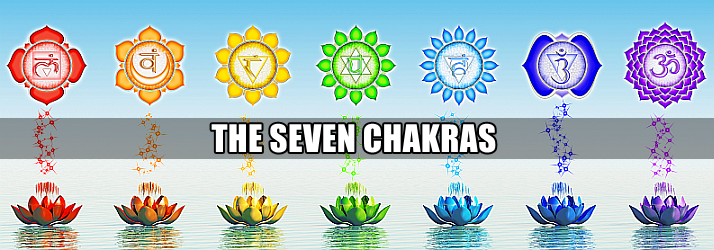
What are Chakras?
The word chakra comes from the Sanskrit word for “spinning wheel.” In order to understand what the 7 chakras of the body are, it is necessary to first have an understanding of the way in which the body works energetically and the energy field or aura. If you just want to find out the name of the seven chakras jump down to next section.
“The soul does not reside in the body; the body resides within the soul.”
That is to say that the soul or spirit encapsulates the body. If this is looked at from the perspective of the aura, it is known that the energy field surrounds the body and can normally be detected up to two or three feet outside of the physical body. Although most people can’t see this energy field, many can feel it through the sense of touch. This is how most energy healers sense their clients’ aura, through placing their hands above the body but within the energy field.
The energy field is made up of a complex system of energy centers or chakras and energy lines or meridians, through which energy flows. In addition to the seven major chakras, there are also numerous minor chakras located throughout the body and energy system. This system, when operating in harmony allows the free flow of energy to and from the body. In this way, the body interacts with and feeds off universal energy, energy from nature, other people’s energy and even energy from electrical devices; the latter being a form of disruptive energy that can interfere with the natural flow of the energy field. The way in which this energetic interaction or flow takes place is mainly through the seven major chakras. Each chakra – if visualized – can be seen as a cone shape emanating from the body with the smallest point starting within the body and growing larger as it reaches out from the physical body. The cone shape can be seen from both sides of the body. Looking at a side profile, the seven chakras of the body can be seen from the front and the back, reaching out in both directions.
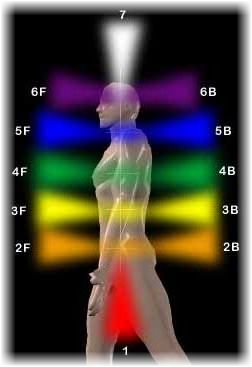
Cone shaped energy emanating from the seven chakras
What are the seven chakras of the human body made up of? The seven chakras in our body are each made up of swirling vortices of energy. It can be easier to understand if the energy is visualized as liquid, similar to a whirlpool. Anything that comes into contact with a whirlpool – leaves/twigs for example, are immediately sucked in and become part of the swirling mass. In a similar way, energy is taken in through the 7 chakras of the body, assimilated and distributed to other points within the body and energy field as needed; although the chakras are intelligent and do not simply suck in anything that is encountered as a whirlpool might. When operating in harmony, the seven chakras perform their task beautifully, giving and receiving energy as and when required. If blocked however, the 7 chakras in our body can be hindered in their function, causing energetic imbalances in the body, which often show up on a physical level as illness.
In addition, the seven chakras in our body are each operating at different frequencies and are assigned distinct colors and attributes. Similar to radio stations working on various frequencies, in order to tune into a specific station it is necessary to tune into its specific frequency. When the seven chakras are aligned to their optimal frequency, they operate in harmony. If the frequency is misaligned or blocked, as with a radio station the signal becomes weak or disrupted and the flow of energy is disturbed. If misaligned, there are ways in which the seven chakras can be opened and cleared, but more on this further on.
What are the 7 Chakras and their Meanings
As mentioned earlier, each of the seven chakras have different colors and attributes. They are also represented symbolically by different flowers. So, what are the seven chakras?
The name of each of the seven chakras in English are: Base Chakra, Sacral Chakra, Solar Plexus Chakra, Heart Chakra, Throat Chakra, Third Eye Chakra, and Crown Chakra.
Let’s go in a little deeper and explain about the seven chakras and their meanings; the names of the seven chakras in Hindi, the seven chakra symbols, flowers, and colors of the 7 chakras of the human body, together with their attributes and functions.
1. Root Chakra – Muladhara
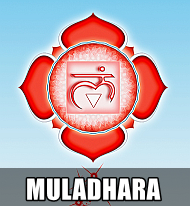 This is known as the first chakra. The Root or Base chakra as it is also called, is located at the base of the spine towards the pelvic region. Represented by the rose, the color of the base chakra is red. Its attributes are self-confidence, peacefulness, vitality, focus and courage. On a physical level the base chakra governs the feet, knees, legs, pelvic region and adrenal glands. Its function energetically is to maintain a balanced and grounded state, while also feeding energy up through to the higher chakras.
This is known as the first chakra. The Root or Base chakra as it is also called, is located at the base of the spine towards the pelvic region. Represented by the rose, the color of the base chakra is red. Its attributes are self-confidence, peacefulness, vitality, focus and courage. On a physical level the base chakra governs the feet, knees, legs, pelvic region and adrenal glands. Its function energetically is to maintain a balanced and grounded state, while also feeding energy up through to the higher chakras.
2. Sacral Chakra – Svadhisthana
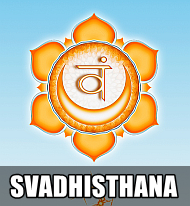 The second of the seven chakras is located just below the naval. Its color is orange and the orange Lily represents it. The attributes of the sacral chakra are creativity, self-worth, wisdom, energy and self-expression. This chakra regulates the reproductive organs, kidneys, lower intestines, hips, bladder and gallbladder. The energetic function of the second chakra is to maintain emotional balance.
The second of the seven chakras is located just below the naval. Its color is orange and the orange Lily represents it. The attributes of the sacral chakra are creativity, self-worth, wisdom, energy and self-expression. This chakra regulates the reproductive organs, kidneys, lower intestines, hips, bladder and gallbladder. The energetic function of the second chakra is to maintain emotional balance.
3. Solar Plexus Chakra – Manipura
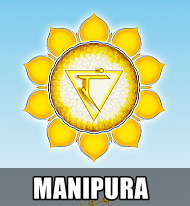 The solar plexus chakra is so named due to its proximity to the solar plexus in the body, its location being just above the naval. Yellow is the color of this third chakra and the sunflower represents it. Some of the attributes of the solar plexus include power, self-confidence, strength, reason and sense of humor. Physically, the solar plexus chakra resides over the stomach, upper intestines, pancreas, lower back and muscles. On an energetic level its function is to optimize personal power and life purpose.
The solar plexus chakra is so named due to its proximity to the solar plexus in the body, its location being just above the naval. Yellow is the color of this third chakra and the sunflower represents it. Some of the attributes of the solar plexus include power, self-confidence, strength, reason and sense of humor. Physically, the solar plexus chakra resides over the stomach, upper intestines, pancreas, lower back and muscles. On an energetic level its function is to optimize personal power and life purpose.
4. Heart Chakra – Anahata
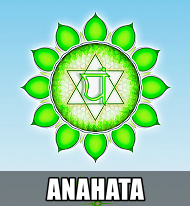 Located in the center of the chest, the heart chakra is the fourth of the seven chakras. The heart chakra is best known for its green color but a secondary color of pink is also associated with this chakra, as symbolized by the pink water Lily growing amongst large green leaves. The main attributes of this chakra are love—self love as well as love for others, compassion, peace and happiness.
Located in the center of the chest, the heart chakra is the fourth of the seven chakras. The heart chakra is best known for its green color but a secondary color of pink is also associated with this chakra, as symbolized by the pink water Lily growing amongst large green leaves. The main attributes of this chakra are love—self love as well as love for others, compassion, peace and happiness.
Of course, on a physical level this chakra governs the heart but also the lungs, upper back, shoulders, arms, chest, breasts, immune and circulatory systems as well as the thymus gland. The function of the heart chakra is unconditional love.
5. Throat Chakra – Vishuddha
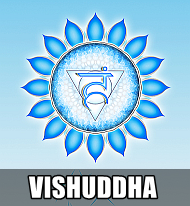 This fifth chakra is located at the base of the neck. The color of the throat chakra is turquoise blue and the flower best known to represent it is the blue tulip. The throat chakra is known for its attributes of self-expression, speaking ones truth and communication. This chakra influences the throat, voice box, neck, thyroid gland and ears. Energetically the function of the throat chakra is to be true to oneself.
This fifth chakra is located at the base of the neck. The color of the throat chakra is turquoise blue and the flower best known to represent it is the blue tulip. The throat chakra is known for its attributes of self-expression, speaking ones truth and communication. This chakra influences the throat, voice box, neck, thyroid gland and ears. Energetically the function of the throat chakra is to be true to oneself.
6. Third Eye Chakra – Ajna
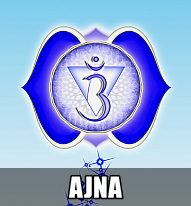 The sixth of the seven chakras, the third eye is located in the center of the forehead. This chakra is traditionally known for its indigo color however; the lighter shade of purple is also associated with the sixth chakra. The corresponding flowers therefore are purple violets or the indigo tulip. The third eye is the seat of intuition, inner knowing, vision, imagination, self-assurance and prophecy. On a physical level the third eye manages the brain, mental processes, eyes, sinuses and nose. From an energetic perspective, the function of this chakra is to know oneself – mentally, emotionally and spiritually.
The sixth of the seven chakras, the third eye is located in the center of the forehead. This chakra is traditionally known for its indigo color however; the lighter shade of purple is also associated with the sixth chakra. The corresponding flowers therefore are purple violets or the indigo tulip. The third eye is the seat of intuition, inner knowing, vision, imagination, self-assurance and prophecy. On a physical level the third eye manages the brain, mental processes, eyes, sinuses and nose. From an energetic perspective, the function of this chakra is to know oneself – mentally, emotionally and spiritually.
7. Crown Chakra – Sahasrara
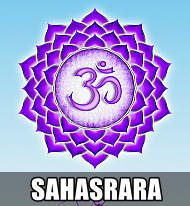 The final chakra of the seven major chakras is the crown chakra located at the top of the head. As with the third eye chakra, this chakra is known for its purple color but the alternative color of white has also been identified with the seventh chakra. As humanity evolves, the colors of the chakras are also evolving and changing, as their vibration increases their associated colors or shades are becoming lighter. The flowers associated with this chakra are the pure white Lily or the purple lotus flower. The crown chakra serves as the connection to source or divine energy. It is the chakra related to spirituality, the higher self or God self, wisdom and the source of divine power. Physically, this chakra governs the nervous system, pineal gland and cerebral cortex. The function of the crown chakra is self-mastery, enlightenment and oneness or connection to all.
The final chakra of the seven major chakras is the crown chakra located at the top of the head. As with the third eye chakra, this chakra is known for its purple color but the alternative color of white has also been identified with the seventh chakra. As humanity evolves, the colors of the chakras are also evolving and changing, as their vibration increases their associated colors or shades are becoming lighter. The flowers associated with this chakra are the pure white Lily or the purple lotus flower. The crown chakra serves as the connection to source or divine energy. It is the chakra related to spirituality, the higher self or God self, wisdom and the source of divine power. Physically, this chakra governs the nervous system, pineal gland and cerebral cortex. The function of the crown chakra is self-mastery, enlightenment and oneness or connection to all.
Next, let’s find out how to open your seven chakras with meditation and chakra stones.
Opening the Seven Chakras
Now that more is understood about the seven chakras, their locations and functions, it is important to know how to open the 7 chakras and clear them of blockages. This energetic self-care is similar to physical cleanliness and is an important part of daily energetic alignment and spiritual maintenance and growth. Most people harbor blockages within the seven chakras and within many of the minor chakras to a greater or lesser degree, depending on their lifestyle, spiritual practices and many other factors such as past or current emotional issues, state of health and so forth. Opening the 7 chakras in order to clear out energetic blockages and with a view to realigning and balancing their frequency is an important aspect of spiritual care. Once the seven chakras are aligned, balanced and functioning at their optimal vibration, the benefits are experienced on all levels, not just spiritually but physically, mentally and emotionally; leading to states of physical health, emotional balance, greater mental clarity and performance and of course heightened spiritual connection and growth.
Seven Chakras Meditation
Meditation is a vital practice in order to open the seven chakras and to maintain their healthy function. There are many forms of seven chakras meditation, some more complex than others. A basic practice that can be attempted by those new to meditation or experienced meditators alike is the practice of chakra mantras. This type of meditation is very calming, easy to practice and very effective in opening and clearing the chakras. The process is to chant a specific mantra either aloud or silently in the mind corresponding to each of the seven chakras. The time spent on each chakra can be decided by the individual as they meditate. If one chakra has a greater blockage than another, more time can be spent reciting the mantra for that chakra. The chakra mantras are as follows:
- Base Chakra – LAM
- Sacral Chakra – VAM
- Solar Plexus – RAM
- Heart Chakra – YAM
- Throat Chakra – HAM
- Third Eye Chakra – SHAM
- Crown Chakra – OM
Yoga is also very beneficial for opening and aligning the seven chakras. There are specific postures that are known for their ability to open and clear the chakras, but the nature of yoga in itself aids the flow of energy when practiced. The movement and poses yoga offers are designed to release blocked energy and encourage the flow of fresh energy through the asanas practiced and breath work.
You can also complement your meditation and yoga practice with “the seven chakra stones”. So let’s find out how to open the seven chakras with healing stones.
The 7 Chakra Stones
The 7 chakra stones or crystals can be used to help open and balance the seven chakras. The colors and frequency or vibration of the crystals when placed in or around each chakra, can help to clear stuck energy and realign the chakras. Crystals are very effective in soaking up heavy energies that can be the cause of blockages. In this respect, when using crystals as a means to open the chakras, it is vital to be careful to ensure that the stones are cleansed after each use in order to maintain their effectiveness – and not to reintroduce negative energy that may have been previously cleared from the chakras but still resides in and around the crystals if left un-cleansed. There are many crystals that are beneficial to open the chakras but the most well known are listed below.

- Base Chakra – Hematite or Red Jasper
- Sacral Chakra – Orange Carnelian
- Solar Plexus – Citrine
- Heart Chakra – Rose Quartz or Green Aventurine
- Throat Chakra – Turquoise or Blue Lace Agate
- Third Eye Chakra – Amethyst
- Crown Chakra – Clear Quartz
To learn more about the chakras and to gain greater insight into the meaning of the chakra colors, read this article.
The Seven Chakras Explained At a Glance
Below is a quick overview of the name, location, color, lower, attributes, mantra, and crystals for each of the seven chakras.
Chakra Name – Base or Root Chakra
Sanskrit Name – Muladhara
Location – Base of the Spine
Color – Red
Flower – Rose
Attributes – Self-Confidence, Peacefulness, Vitality, Focus & Courage
Mantra – LAM
Crystal – Hematite or Red Jasper
Chakra Name – Sacral Chakra
Sanskrit Name – Svadhisthana
Location – Below the Naval
Color – Orange
Flower – Orange Lily
Attributes – Creativity, Self-Worth, Wisdom, Energy and Self-Expression
Mantra – VAM
Crystal – Orange Carnelian
Chakra Name – Solar Plexus Chakra
Sanskrit Name – Manipura
Location – Above the Naval
Color – Yellow
Flower – Sunflower
Attributes – Power, Self-Confidence, Strength, Reason & Sense of Humor
Mantra – RAM
Crystal – Citrine
Chakra Name – Heart Chakra
Sanskrit Name – Anahata
Location – Centre of the Chest
Color – Green & Pink
Flower – Water Lily
Attributes – Love—Self-Love as well as Love for Others, Compassion, Peace & Happiness
Mantra – YAM
Crystal – Rose Quartz or Green Aventurine
Chakra Name – Throat Chakra
Sanskrit Name – Vishuddha
Location – Base of the Neck
Color – Turquoise Blue
Flower – Blue Tulip
Attributes – Self-Expression, Speaking Ones Truth & Communication
Mantra – HAM
Crystal – Turquoise or Blue Lace Agate
Chakra Name – Third Eye Chakra
Sanskrit Name – Ajna
Location – Centre of the Forehead
Color – Indigo or Purple
Flower – Purple Violets or Indigo Tulip
Attributes – Seat of Intuition, Inner Knowing, Vision, Imagination, Self-Assurance & Prophecy
Mantra – SHAM
Crystal – Amethyst
Chakra Name – Crown Chakra
Sanskrit Name – Sahasrara
Location – Top of the Head
Color – Purple or White
Flower – Purple Lotus or White Lily
Attributes – Spirituality, Connection to the Higher-Self or God-Self, Wisdom & Source of Divine Power.
Mantra – OM
Crystal – Clear Quartz


